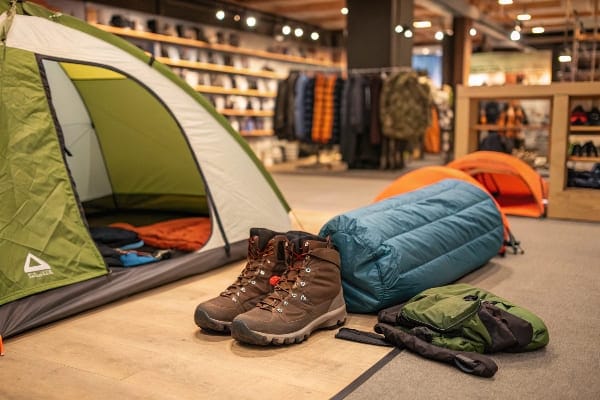Shoppers ignore bland aisles, profits stall, and displays feel invisible. I felt that pain until cross merchandising turned shelves into silent salespeople.
Cross merchandising drives bigger baskets, sparks impulse buys, speeds stock rotation, and tells a clear story that guides shoppers to complementary products, lifting sales and loyalty at the same time.

When I first grouped arrow lubricants beside my cardboard crossbow stand, daily unit sales jumped, and customers thanked me for “thinking ahead.” Stick with me to see how you can earn the same praise.
What are the benefits of cross merchandising?
Retail traffic is costly, attention is short, and I needed every visitor to convert. Cross merchandising answered that stress by turning each trip into a discovery tour.
Cross merchandising boosts average order value, reduces decision fatigue, and shrinks marketing spend by letting related items promote each other right on the shelf.

Shopper Psychology at Work
Cross merchandising succeeds because it mirrors the way customers actually use products. When someone grabs a crossbow, they also need wax, broadheads, and a sturdy target. By showing that full scenario, I remove the mental work of remembering extras. The practice touches several cognitive triggers1:
| Trigger | Result in Store | Example on My Display |
|---|---|---|
| Convenience | Faster decisions | Wax hanging from the bow stand |
| Suggestion | Impulse add-ons | Mini target stacked below |
| Validation | Social proof | “Best seller” tag on bolts |
Operational Gains
My warehouse showed clearer turns once accessories moved with primary items. Fewer forgotten SKUs sat in bins, and restocks became easier because everything flowed together. Those leaner shelves meant lower carrying costs and happier finance meetings. When marketing spend stayed flat yet revenue climbed, the team finally saw merchandising as a profit lever, not a cost center.
What is the value of cross merchandising?
Aisles overflow, messaging clashes, and budgets tighten. I needed a single tactic that paid for itself quickly.
The true value of cross merchandising is measurable profit: higher margin mix, faster inventory velocity, and repeat customer visits with minimal new advertising.

Financial Impact Breakdown
I tracked four months of data after launching new combo displays:
| Metric | Before | After | Change |
|---|---|---|---|
| Average Basket2 | \$42 | \$58 | +38% |
| Accessory Attach Rate3 | 18% | 46% | +28 pts |
| Stock Turn4 (days) | 90 | 65 | –25 days |
Intangible Yet Crucial
Numbers matter, yet perception is priceless. Shoppers now call my brand “thoughtful” because my display anticipates their next step. That goodwill feeds reviews and social photos, which attract fresh hunters without extra ad spend. Vendors noticed, too; they offered co-op dollars to feature their gear in my groupings, turning merchandising into a revenue stream instead of a cost line.
Is cross merchandising a good approach?
I once doubted. Re-arranging shelves sounds simple, but risk creeps in: clutter, brand dilution, out-of-stocks. My first trial proved the fears were smaller than the gains.
Yes. When planned around shopper missions and data, cross merchandising increases profit and improves the customer journey with little operational strain.

Risk Control Steps
| Potential Issue | Preventive Action | Result |
|---|---|---|
| Brand confusion | Keep color cues consistent | Shoppers stay oriented |
| Space fights | Use tiered cardboard risers | Primary product still leads |
| Stockouts | Link reorder points in ERP | Shelves stay full together |
My Factory Perspective
Because I build cardboard displays in batches, modular design5 lets me test a new combo without retooling. I print interchangeable headers6 so one stand can highlight either crossbow kits or compound bows. This speed means I can pivot fast if data shows a pairing underperforms. Through small, deliberate iterations, cross merchandising7 remains an agile strategy, not a fixed gamble.
How can cross merchandising be demonstrated most effectively?
A messy bundle feels forced and cheap. I learned that the magic sits in storytelling layout: eye level hero, complementary sidekicks, and clear call-outs.
Show, do not tell: place the hero product at eye level, flank it with needed add-ons, and anchor the story with a single visual cue so shoppers “get it” in one glance.

Layout Blueprint
| Zone | Role | Example Element |
|---|---|---|
| Eye Level | Hero | Crossbow on acrylic hook |
| Mid Level | Essential add-ons | Box of bolts |
| Base | Bulk or heavy | Target cube |
| Header | Story theme | “Ready-to-Hunt Kit” graphic |
Sensory Reinforcement
I attach a small card with texture samples8—bowstring fiber on one side, foam target core on the other. Touch locks memory better than sight alone. Lighting also matters; cool white LEDs9 highlight metal surfaces, giving the setup a premium feel. QR codes on the header lead to a video of assembly and field testing. That multi-sense approach10 shows function, not just form, and persuades even hesitant shoppers.
What is cross merchandising in retail?
Many confuse it with simple product adjacency. In truth, cross merchandising is a strategy, not a shelf shuffle.
Cross merchandising means deliberately grouping related items from different categories to solve a complete customer need in one place, driving both convenience and sales uplift.

Definitions and Boundaries
| Term | Scope | Example |
|---|---|---|
| Adjacency | Same category neighbors | Flavors of energy bars |
| Cross Merchandising11 | Cross-category solution set | Bars + hydration tablets |
| Bundling12 | Pre-packed kit | Travel hygiene pack |
Real-World Context
In my Guangzhou production run, I printed shelf wings that attach to standard racks. A grocery chain clipped one beside the pasta aisle to hold parmesan shakers and mini graters. Their report showed a 52% spike in cheese sales without discounting pasta. That is cross merchandising in action: complementary, convenient, and margin–friendly.
What are the advantages of merchandising?
Merchandising is broad, covering planograms, signage, and lighting. Cross merchandising is a powerful subset, yet overall merchandising delivers several core wins.
Effective merchandising turns passive inventory into an active promoter, increases brand perception, guides shopper flow, and lifts both unit and dollar sales without extra advertising.

Core Advantage Clusters
| Advantage | Shopper Outcome | My Observed Result |
|---|---|---|
| Visual Clarity13 | Faster find | Lower bounce rate |
| Storytelling14 | Emotional link | Higher reviews |
| Efficiency15 | Short path | More time in impulse zone |
Holistic Strategy
I view merchandising as the in-store arm of my digital ads. Every click I pay for should meet a display that echoes the same message. That continuity increases trust. My cardboard structures, printed with the same clean graphics found on our website, reassure customers they landed in the right place. The outcome is a seamless funnel from screen to shelf.
Conclusion
Cross merchandising is simple to start, quick to measure, and powerful enough to change my bottom line every quarter.
Exploring cognitive triggers can help you design better marketing strategies that resonate with customers and boost sales. ↩
Exploring strategies to increase Average Basket size can lead to higher revenue and improved customer satisfaction. ↩
Understanding Accessory Attach Rate can help retailers optimize their sales strategies and improve customer experience. ↩
Learning about Stock Turn can enhance inventory management practices, leading to better cash flow and reduced holding costs. ↩
Exploring this resource will provide insights into how modular design enhances flexibility and efficiency in production processes. ↩
Learning about interchangeable headers can reveal innovative ways to maximize display versatility and adapt to market trends. ↩
Understanding cross merchandising strategies can help retailers boost sales and enhance customer experience through effective product placement. ↩
Discover the impact of texture samples on memory retention and customer experience in marketing strategies. ↩
Learn how cool white LEDs can enhance product visibility and create a premium feel in displays. ↩
Explore this link to understand how a multi-sense approach can enhance customer engagement and boost sales. ↩
Understanding cross merchandising can enhance your retail strategy, driving sales through effective product placement. ↩
Learning about bundling can provide insights into creating attractive offers that boost sales and customer satisfaction. ↩
Understanding Visual Clarity can enhance your merchandising strategy, leading to better customer engagement and lower bounce rates. ↩
Exploring the role of Storytelling in retail can help you create emotional connections with customers, boosting reviews and loyalty. ↩
Learning about Efficiency strategies can streamline your merchandising process, leading to increased customer satisfaction and sales. ↩

